Family: Tenthredinidae
Family common name: common sawflies
Subfamily: Blennocampinae
Tribe: Waldheimiini
Genus: Waldheimia Brulle, 1846
Subgenera: none
The Tenthredinidae are the most species-rich family and are found throughout the world, in all continents but Antarctica. They are known as the “common sawflies.” They can generally be recognized by a cylindrical body and long, segmented antennaeantenna:
the sensory organ emerging from the front of the head, usually between the compound eyes and above the clypeus; includes the flagellum, scape and pedicel
 . Otherwise, they come in a variety of colors, sizes, and forms (Goulet 1992Goulet 1992:
. Otherwise, they come in a variety of colors, sizes, and forms (Goulet 1992Goulet 1992:
Goulet H. 1992. The genera and subgenera of the sawflies of Canada and Alaska: Hymenoptera. Symphyta. The insects and arachnids of Canada. Part 20. Agriculture Canada Publication.).
Sawflies in the subfamily Blennocampinae have a diverse set of life histories and habits. Many species are restricted to subtropical and tropical regions, but the genus is still fairly species-rich in North America. Blennocampinae includes many sawflies that feed on ornamental and forestry crops. This subfamily can be recognized by wing venationvenation:
the network of veins on a wing
and bidentatebidentate:
having two teeth; often used in descrbing mandibles or tarsal claws
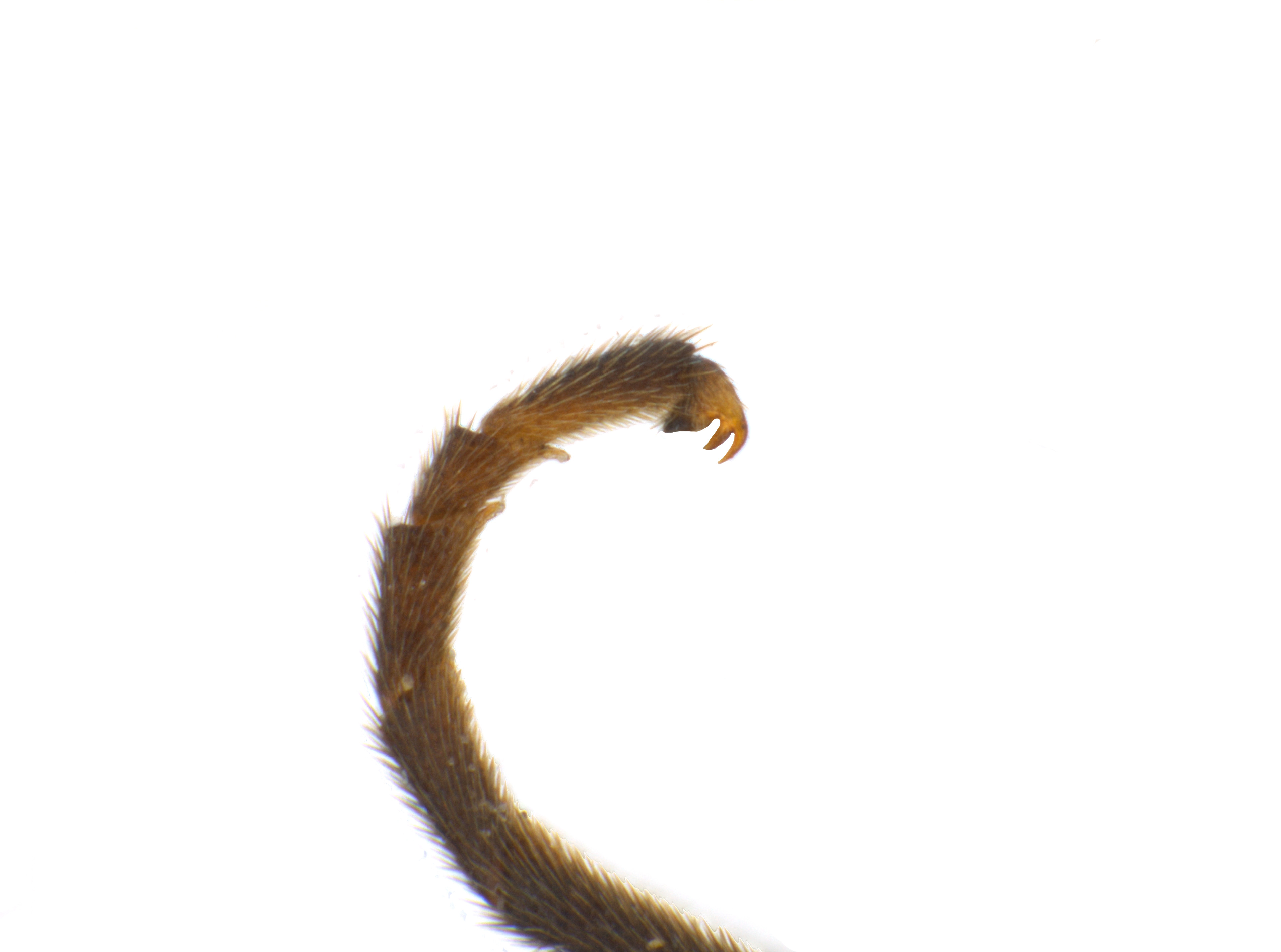 mandibles (Smith 1969dSmith 1969d:
mandibles (Smith 1969dSmith 1969d:
Smith DR. 1969d. Nearctic Sawflies. I. Blennocampinae: Adults and larvae (Hymenoptera: Tenthredinidae). Technical Bulletin, U.S. Department of Agriculture 1397: 1-176.).
Waldheimia are about 6.5–8.5 mm in length, and many species are orange with black markings and darkened wings (Smith 1969dSmith 1969d:
Smith DR. 1969d. Nearctic Sawflies. I. Blennocampinae: Adults and larvae (Hymenoptera: Tenthredinidae). Technical Bulletin, U.S. Department of Agriculture 1397: 1-176.). The genus is most species-rich in the NeotropicalNeotropical:
Describing the region of the Western Hemisphere that is tropical, ie. between 30°N and 30°S of the equator; includes southern Mexico, Central America, the Caribbean and South America
 region (Taeger et al. 2018Taeger et al. 2018:
region (Taeger et al. 2018Taeger et al. 2018:
Taeger A, Liston AD, Prous M, Groll EK, Gehroldt T, and Blank SM. 2018. ECatSymmdash;Electronic World Catalog of Symphyta (Insecta, Hymenoptera). Program version 5.0 (19 Dec 2018), data version 40 (23 Sep 2018). Senckenberg Deutsches Entomologisches Institut (SDEI), Muuml;ncheberg. https://sdei.de/ecatsym/ Accessed: 28 Jan 2020.).
There are 70 described extantextant:
in existence; opposite of extinct
species worldwide. Three species occur north of Mexico (Boevé et al. 2016, Taeger et al. 2018Taeger et al. 2018:
Taeger A, Liston AD, Prous M, Groll EK, Gehroldt T, and Blank SM. 2018. ECatSymmdash;Electronic World Catalog of Symphyta (Insecta, Hymenoptera). Program version 5.0 (19 Dec 2018), data version 40 (23 Sep 2018). Senckenberg Deutsches Entomologisches Institut (SDEI), Muuml;ncheberg. https://sdei.de/ecatsym/ Accessed: 28 Jan 2020.).
In the Blennocampinae monograph (Smith 1969dSmith 1969d:
Smith DR. 1969d. Nearctic Sawflies. I. Blennocampinae: Adults and larvae (Hymenoptera: Tenthredinidae). Technical Bulletin, U.S. Department of Agriculture 1397: 1-176.), Erythraspides is treated as a separate genus. The two genera have since been synonymized, and the keys to species of both genera can be used for species determination of Waldheimia (Taeger et al. 2010Taeger et al. 2010:
Taeger A, Blank SM, and Liston AD. 2010. World Catalog of Symphyta (Hymenoptera). Zootaxa 2580: 1-1064.).
Subfamily characters
 veins Cu1 and 1m-cu between 120°–150° (Goulet 1992Goulet 1992:
veins Cu1 and 1m-cu between 120°–150° (Goulet 1992Goulet 1992: veins M and 1m-cu parallel (Smith 1969dSmith 1969d:
veins M and 1m-cu parallel (Smith 1969dSmith 1969d: veins 2A and 3A incomplete (Smith 1969dSmith 1969d:
veins 2A and 3A incomplete (Smith 1969dSmith 1969d:Genus characters
 light-colored and thin; dry specimens often with collapsed antennaeantenna:
light-colored and thin; dry specimens often with collapsed antennaeantenna: (Goulet 1992Goulet 1992:
(Goulet 1992Goulet 1992: longer than wide (Smith 1969dSmith 1969d:
longer than wide (Smith 1969dSmith 1969d: veins 2A and 3A straight at apexapex:
veins 2A and 3A straight at apexapex: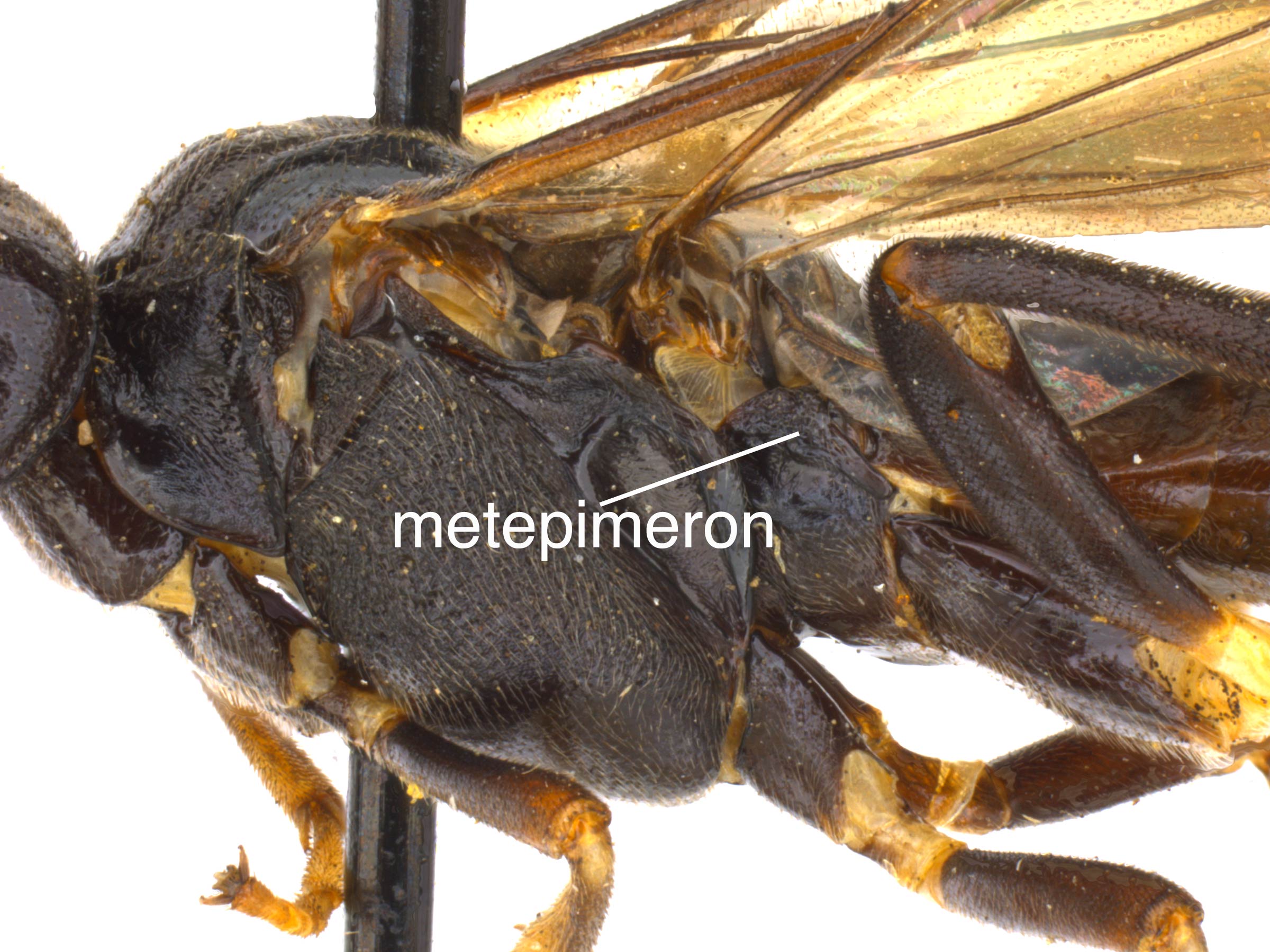 near the hind coxaecoxa:
near the hind coxaecoxa: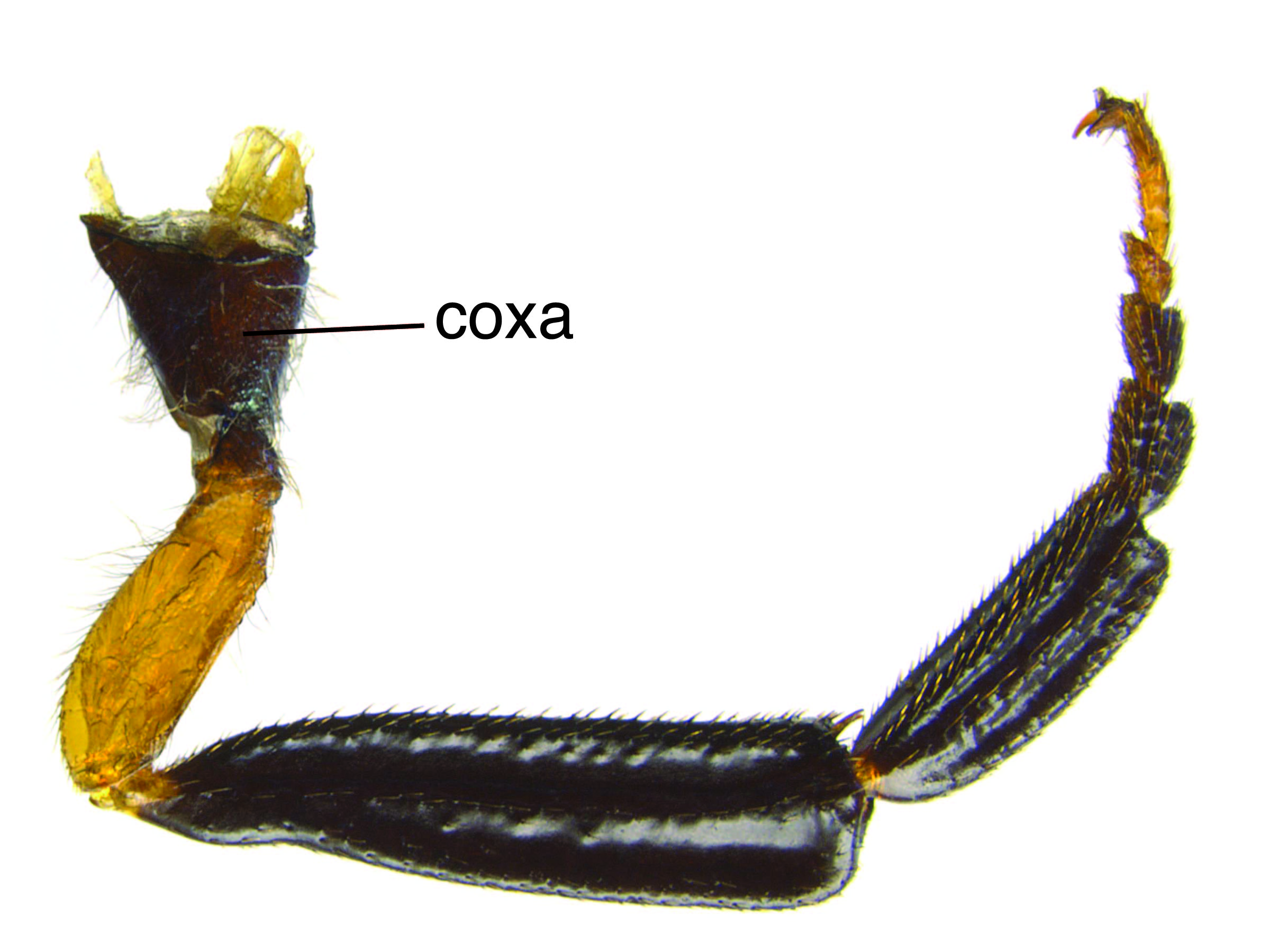 (Goulet 1992Goulet 1992:
(Goulet 1992Goulet 1992: basalbasal:
basalbasal: inner tooth long (Goulet 1992Goulet 1992:
inner tooth long (Goulet 1992Goulet 1992:Waldheimia can be distinguished from other genera in the subfamily Blennocampinae by the lack of pulvillipulvillus:
soft pads used for surface adhesion, located in sawflies on the first 4 segments of the tarsus
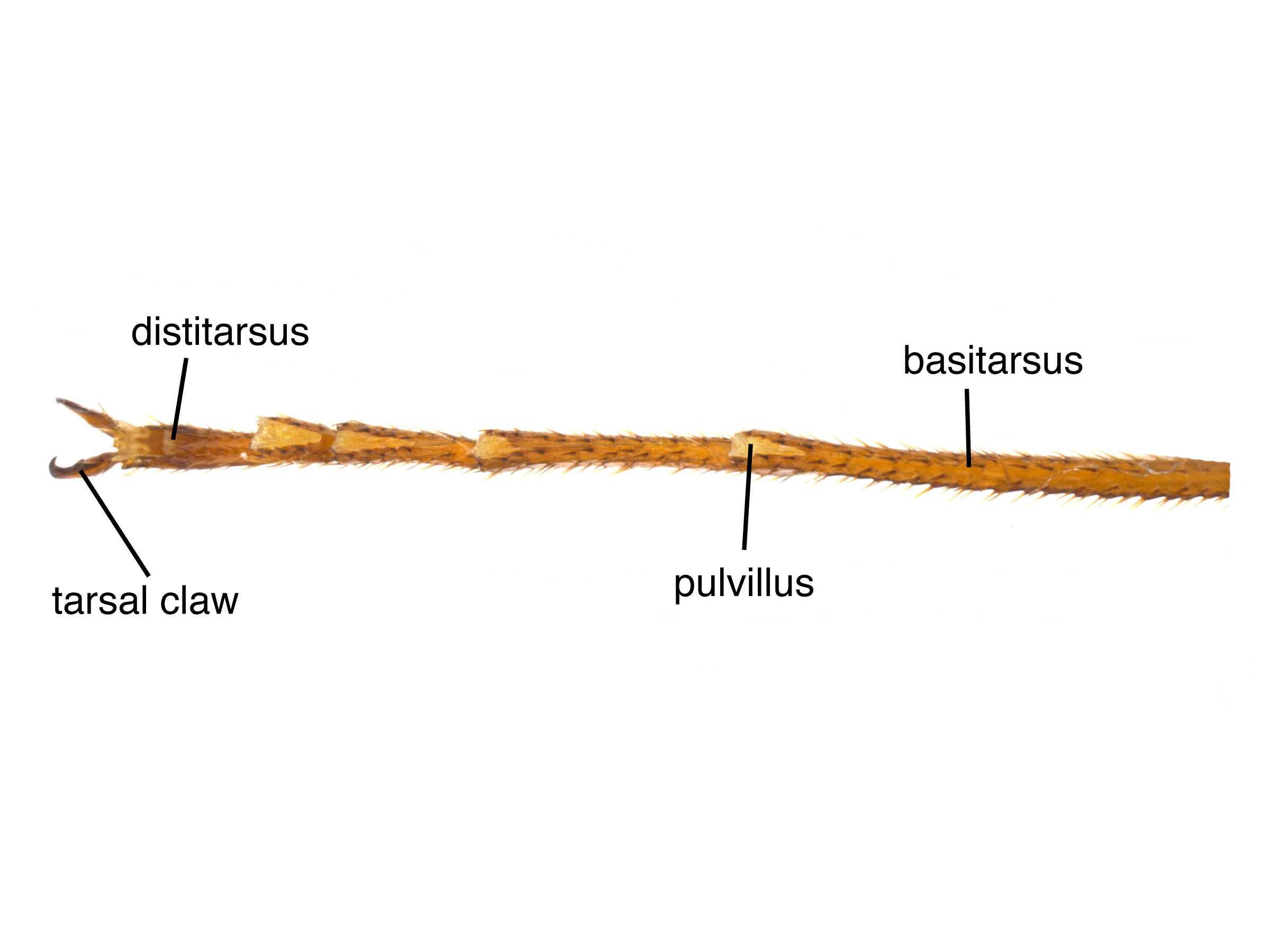 on the basalbasal:
on the basalbasal:
towards the base; closest to the body
tarsomeres and by short apicalapical:
towards the apex; farthest away from the body
antennal segments, and from closely related Halidamia by the straight apexapex:
the end or most distal area of any structure
of fore wingfore wing:
the anterior wing of each pair of wings; usually the largest wing of the pair
 veins 2A and 3A (Smith 1969dSmith 1969d:
veins 2A and 3A (Smith 1969dSmith 1969d:
Smith DR. 1969d. Nearctic Sawflies. I. Blennocampinae: Adults and larvae (Hymenoptera: Tenthredinidae). Technical Bulletin, U.S. Department of Agriculture 1397: 1-176.).
none
North of Mexico, W. carbonaria feeds on Oenothera missouriensis (Missouri primrose) (Smith and Williams 2014Smith and Williams 2014:
Smith DR and Williams G. 2014. Waldheimia carbonaria (Cresson) (Hymenoptera: Tenthredinidae), a sawfly on Missouri primrose, Oenothera missouriensis Sims (Onagraceae). Proceedings of the Entomological Society of Washington 116 (2): 197-198.), and W. vitis feeds on Vitis sp. (grape) (Smith 1969dSmith 1969d:
Smith DR. 1969d. Nearctic Sawflies. I. Blennocampinae: Adults and larvae (Hymenoptera: Tenthredinidae). Technical Bulletin, U.S. Department of Agriculture 1397: 1-176.). In Central America, hosts include Saurauia montana, Cissus alata (grape ivy), Cissus rhombiflora (grape ivy), Cissus verticillata (princess vine), and Davilla nitida (Smith 1995Smith 1995:
Smith DR. 1995. The sawflies and woodwasps. In: Hanson PE and Gauld ID, eds. The Hymenoptera of Costa Rica. Oxford University Press. Pp. 157-177., Smith et al. 2013Smith et al. 2013:
Smith DR, Janzen DH and Hallwachs W. 2013. Food plants and life histories of sawflies of the families Argidae and Tenthredinidae (Hymenoptera) in Costa Rica, a supplement. Journal of Hymenoptera Research 35: 17-31. https://doi.org/10.3897/JHR.35.5496, Smith and Williams 2014Smith and Williams 2014:
Smith DR and Williams G. 2014. Waldheimia carbonaria (Cresson) (Hymenoptera: Tenthredinidae), a sawfly on Missouri primrose, Oenothera missouriensis Sims (Onagraceae). Proceedings of the Entomological Society of Washington 116 (2): 197-198., Smith and Nishida 2019Smith and Nishida 2019:
Smith DR and Nishida K. 2019. A new genus and three new species of Neotropical sawflies (Hymenoptera, Tenthredinidae) from Costa Rica, with host plants and life history notes. Journal of Hymenoptera Research 72: 45-65. https://doi.org/10.3897/jhr.72.38908).
Waldheimia carbonaria is an external leaf feeder with more than one generation per year. The larvaelarva:
the immature stage of holometabolous insects
 are pale green and feed on the leaves near the mid veinvein:
are pale green and feed on the leaves near the mid veinvein:
a tube-like, often darkened, structure on the wings
 . This species has been recorded defoliating entire plants. Waldheimia are recorded as pupating “naked,” meaning they don’t burrow or spin a cocoon and instead pupate inside the shed skin of the prepupaprepupa:
. This species has been recorded defoliating entire plants. Waldheimia are recorded as pupating “naked,” meaning they don’t burrow or spin a cocoon and instead pupate inside the shed skin of the prepupaprepupa:
the active, non-feeding life stage in which the larva prepares to enter the pupal stage
(Smith et al. 2013Smith et al. 2013:
Smith DR, Janzen DH and Hallwachs W. 2013. Food plants and life histories of sawflies of the families Argidae and Tenthredinidae (Hymenoptera) in Costa Rica, a supplement. Journal of Hymenoptera Research 35: 17-31. https://doi.org/10.3897/JHR.35.5496, Smith and Williams 2014Smith and Williams 2014:
Smith DR and Williams G. 2014. Waldheimia carbonaria (Cresson) (Hymenoptera: Tenthredinidae), a sawfly on Missouri primrose, Oenothera missouriensis Sims (Onagraceae). Proceedings of the Entomological Society of Washington 116 (2): 197-198.).
World: This genus is restricted to the Western Hemisphere and occurs in North and South America as far south as Argentina, including Central America and the Caribbean Islands (Taeger et al. 2010Taeger et al. 2010:
Taeger A, Blank SM, and Liston AD. 2010. World Catalog of Symphyta (Hymenoptera). Zootaxa 2580: 1-1064., Smith et al. 2013Smith et al. 2013:
Smith DR, Janzen DH and Hallwachs W. 2013. Food plants and life histories of sawflies of the families Argidae and Tenthredinidae (Hymenoptera) in Costa Rica, a supplement. Journal of Hymenoptera Research 35: 17-31. https://doi.org/10.3897/JHR.35.5496, Taeger et al. 2018Taeger et al. 2018:
Taeger A, Liston AD, Prous M, Groll EK, Gehroldt T, and Blank SM. 2018. ECatSymmdash;Electronic World Catalog of Symphyta (Insecta, Hymenoptera). Program version 5.0 (19 Dec 2018), data version 40 (23 Sep 2018). Senckenberg Deutsches Entomologisches Institut (SDEI), Muuml;ncheberg. https://sdei.de/ecatsym/ Accessed: 28 Jan 2020.).
North America: Waldheimia occurs in southeastern Canada, and throughout the continental United States east of the Rocky Mountains and south into Arizona and Texas in the west (Smith 1969dSmith 1969d:
Smith DR. 1969d. Nearctic Sawflies. I. Blennocampinae: Adults and larvae (Hymenoptera: Tenthredinidae). Technical Bulletin, U.S. Department of Agriculture 1397: 1-176.). Waldheimia species also occur in Central America, including Guatemala, Costacosta:
the robust vein on the anterior margin of the wing; vein C
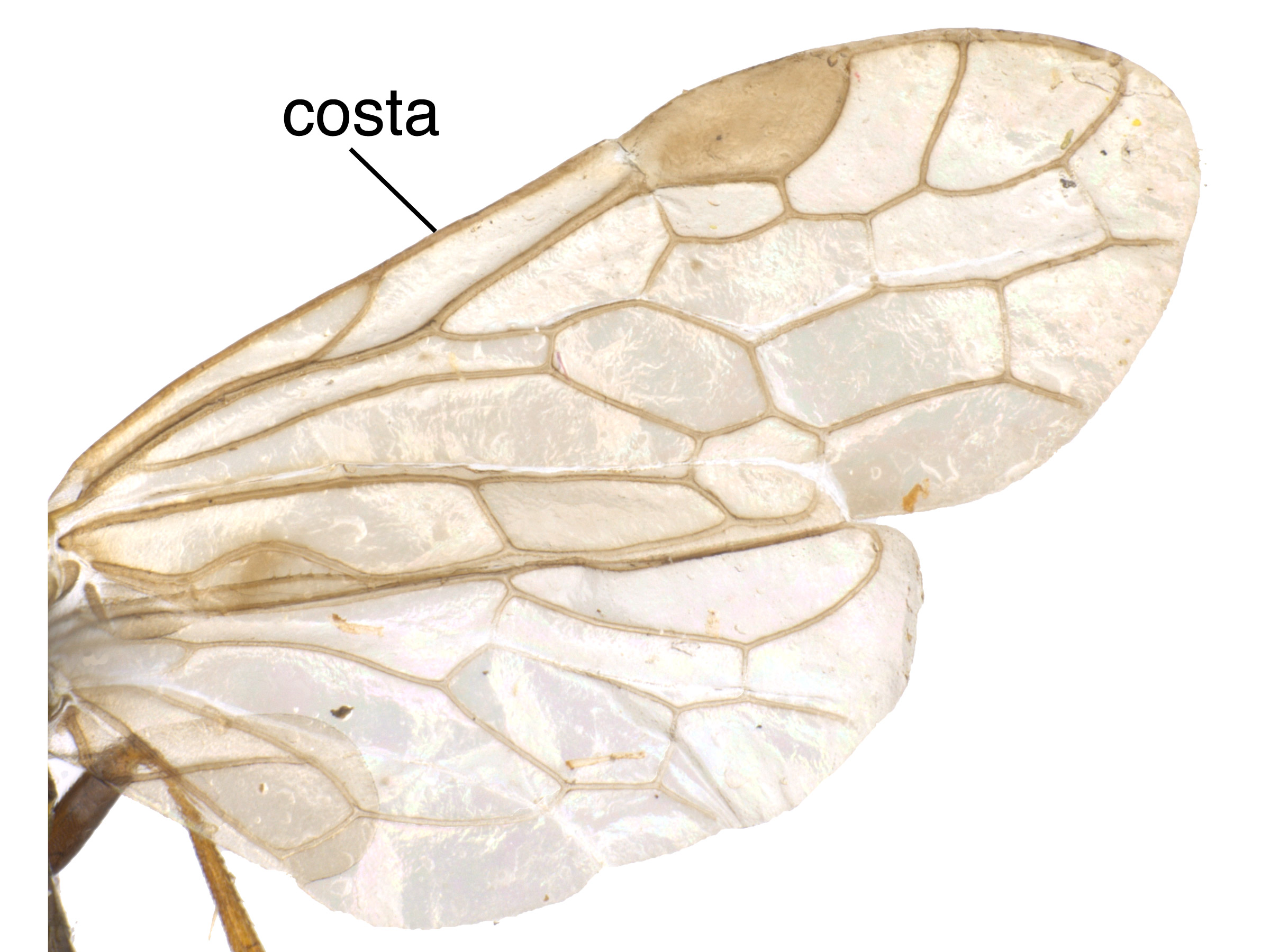 Rica, and Panama, and in Trinidad (Rohwer 1912Rohwer 1912:
Rica, and Panama, and in Trinidad (Rohwer 1912Rohwer 1912:
Rohwer SA. 1912. Sawflies from Panama, with descriptions of new genera and species. Smithsonian Miscellaneous Collections 59 (12): 1-6., Smith et al. 2013Smith et al. 2013:
Smith DR, Janzen DH and Hallwachs W. 2013. Food plants and life histories of sawflies of the families Argidae and Tenthredinidae (Hymenoptera) in Costa Rica, a supplement. Journal of Hymenoptera Research 35: 17-31. https://doi.org/10.3897/JHR.35.5496, Taeger et al. 2018Taeger et al. 2018:
Taeger A, Liston AD, Prous M, Groll EK, Gehroldt T, and Blank SM. 2018. ECatSymmdash;Electronic World Catalog of Symphyta (Insecta, Hymenoptera). Program version 5.0 (19 Dec 2018), data version 40 (23 Sep 2018). Senckenberg Deutsches Entomologisches Institut (SDEI), Muuml;ncheberg. https://sdei.de/ecatsym/ Accessed: 28 Jan 2020.).
Map data from: GBIF.org (29 October 2019) GBIF Occurrence Download Waldheimia and the Smithsonian National Museum of Natural History Entomology Collection (USNM)
Details about data used for maps can be found here.